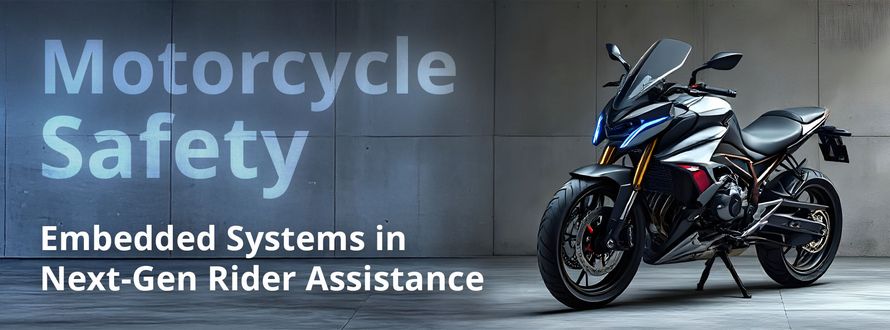
Advancements in Motorcycle Safety: The Role of Embedded Systems in Next-Generation Rider Assistance
– PikeOS, Automotive, Safety, SecurityMotorcycles provide unmatched freedom and performance, but they also present higher risks compared to passenger vehicles. As safety expectations grow, Advanced Driver Assistance Systems (ADAS) for motorcycles are emerging as key technologies to reduce accidents and enhance rider confidence. These systems rely on embedded computing, real-time control, and functional safety-certified software, making them central to the next generation of two-wheeled mobility.
A key enabler is PikeOS, a safety-certified Real-Time Operating System (RTOS) and hypervisor. It allows multiple critical and non-critical applications to run on a single ECU, ensuring deterministic performance, isolation, and secure virtualization. This article explores how embedded systems and PikeOS are shaping modern motorcycle ADAS, highlights fundamental differences from automotive ADAS, and points toward the future of safer motorbike technology.
Motorcycle ADAS: Beyond Automotive Systems
Motorcycle ADAS differs fundamentally from automotive systems due to unique vehicle dynamics. Motorbikes require the system to account for lean angles, rider input, and high-frequency vibrations, which are measured using an Inertial Measurement Unit (IMU).
Key motorcycle ADAS features include:
- Adaptive Cruise Control (ACC)
Uses radar or lidar to maintain a safe distance from vehicles ahead. Unlike cars, the system must consider the lean angle. For example, when following a vehicle in a curve, the radar may lose direct contact. Without IMU-based orientation data, ACC could erroneously accelerate while fully leaned, destabilizing the rider. - Cornering ABS and Cornering Traction Control
These systems continuously monitor wheel speed, lean angle, and tire grip to subtly adjust braking and traction. Instead of applying braking instantly, the system complements the rider’s input, enhancing stability during emergency maneuvers. - Cornering Light
Adjusts headlight angle according to lean, improving visibility in curves. - Riding Mode
Configures engine response, traction control, and ABS according to rider preference or conditions (sport, touring, rain). - TPMS (Tire Pressure Monitoring System)
Ensures optimal tire pressure in real-time, critical for cornering performance and safety. - Sensor Fusion
Combines radar, lidar, and camera data for robust detection and situational awareness. High-resolution multi-sensor fusion is crucial for functions like blind spot detection or collision warnings, especially when leaning or cornering. - eCall Emergency System
Automatically alerts emergency services in the event of a crash, transmitting GPS location and impact severity. Requires fast boot and fail-operational design to remain functional even if part of the ECU fails.
Each of these ADAS features relies on a robust embedded software environment capable of running multiple applications safely and efficiently—often on shared hardware.
Comparing Automotive and Motorcycle ADAS
While automotive ADAS has matured significantly, motorcycle ADAS is fundamentally different:
| Vehicle Dynamics | Stable chassis, 4 wheels | Lean angles, single-track vehicle |
|---|---|---|
| Braking & Traction | More forgiving; ABS handles full stop | Braking must be subtle; traction control must consider rider input |
| Sensor Fusion | Radar/Lidar/Camera for position on flat plane | Requires IMU for orientation; radar alone insufficient in curves |
| Stability Concerns | Minor stability corrections | High sensitivity; miscalculation can destabilize the bike |
| ECU Integration | Multiple ECUs tolerated | ECU count minimized due to weight, space, and power constraints |
| Connectivity & Infotainment | CarPlay, Android Auto standard | Increasingly demanded, but brand-specific systems often regress |
This comparison highlights the technical challenges in adapting automotive ADAS to motorcycles, especially for dynamic control and rider-assistance systems.
Embedded System Challenges in Motorbike ADAS
Motorcycle embedded systems must meet strict requirements:
- Space & Power Efficiency – Limited chassis space and battery capacity demand lightweight, low-power ECUs
- Real-Time Performance – Sensor fusion and actuation loops must execute within microseconds to react correctly to curves, lean, and sudden rider input
- Mixed-Criticality – Safety-critical ADAS (cornering ABS, cornering traction control, ACC) must coexist with infotainment systems, including CarPlay and Android Auto, without interference
- Functional Safety & Cybersecurity – Compliance with ISO 26262 ASIL D and ISO/SAE 21434 protects both rider safety and connected systems from cyber threats
- Environmental Resilience – ECUs must tolerate vibration, temperature extremes, and outdoor exposure, typical for motorcycles
Brand-specific infotainment solutions are often regressing due to market pressures, so having a safe, flexible embedded platform that can run multiple OSes is critical for OEM competitiveness. This is where PikeOS RTOS & Hypervisor stands out as a proven foundation.
PikeOS: The Certified RTOS & Hypervisor for Motorbike Applications
PikeOS offers a partitioned RTOS and hypervisor architecture designed for mixed-criticality embedded systems. It enables safety-certified ADAS to coexist with non-critical applications, such as digital dashboards and connectivity services.
Advantages of PikeOS for Motorbike ADAS
- ISO 26262 ASIL D Certification
- Accelerates approval for safety-critical applications like Cornering ABS, Cornering Traction Control, and ACC
- Time & Space Partitioning
- Strict separation between safety-critical and non-critical workloads ensures deterministic performance
- Guest OS Support
- Allows Linux or Android-based infotainment systems to run alongside safety-certified applications in isolated partitions
- Enables rider interfaces like digital dashboards, HUDs, and navigation without compromising safety
- Lightweight Virtualization
- Reduces ECU count by consolidating multiple applications, minimizing weight, wiring complexity, and cost—critical for motorcycles
- Deterministic Real-Time Performance
- Ensures IMU-based sensor fusion, cornering maneuvers, and adaptive braking meet microsecond-level deadlines for critical ADAS responses
- AI & Machine Learning Readiness
- Supports predictive cornering assistance, adaptive riding modes, and suspension adjustments, or rider behavior analysis
- Cybersecurity by Design
- Implements secure partitioning and communication to protect connected features like V2X and OTA updates
- Fast Boot & Fail-Operational Capabilities
- Safety-critical systems like eCall, TPMS, and cornering ABS remain operational even under failure conditions
Use Cases of PikeOS in Motorbike Safety
- Premium Touring Bikes
ACC, blind spot detection, Lane Assist, and Riding Mode adjustments on a consolidated ECU - High-Performance Sports Motorcycles
Real-time Cornering Traction Control and Cornering ABS to enhance high-speed maneuvering stability - Urban Mobility and Electric Motorbikes
Lightweight, power-efficient platforms running TPMS, eCall, emergency alerts, and sensor fusion, improving rider safety in city traffic
Future Outlook: Smarter and semi-autonomous Motorbikes
The next decade will see the rise of AI-driven ADAS, predictive safety features, and connected riding ecosystems. While full autonomy remains a long-term goal, semi-autonomous assistance will become standard on motorcycles. With its safety certification, deterministic real-time performance, and virtualization capabilities, PikeOS is poised to be a cornerstone of this evolution, enabling OEMs to integrate next-generation features safely, keep ECU count low, and maintain high system performance—laying the foundation for innovative, future-ready motorcycles.
Conclusion
The fusion of motorcycle ADAS and embedded real-time operating systems is transforming two-wheeled safety. Leveraging IMU-based sensor fusion, Adaptive Cruise Control, Cornering ABS, TPMS, and other advanced features, PikeOS RTOS & Hypervisor delivers the safety certification, deterministic performance, and flexible virtualization that OEMs need to build the next generation of rider assistance systems. As the industry moves toward connected, intelligent, and semi-autonomous motorcycles, PikeOS provides the secure, real-time foundation to ensure safety, performance, and innovation go hand in hand, enabling OEMs to create safer, smarter, and more connected motorbikes for the future.
-
Previous
-
Next

 Twitter
Twitter LinkedIn
LinkedIn Facebook
Facebook Reddit
Reddit RSS
RSS Copy link
Copy link
